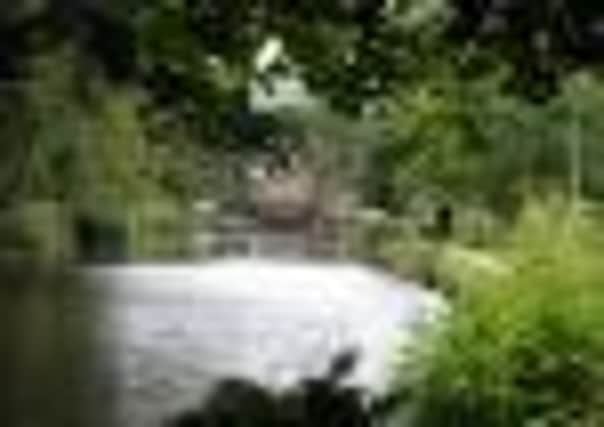Profile On... Mytholmroyd and Hebden Bridge


The writer, Glyn Hughes, who died in May, lived in and wrote about Calderdale for more than 40 years. He insisted its character was determined by geology, the millstone grit, whose blackened outcrops he likened to “the bones [that] press through the flesh of a hungry cow”.
The grit throws off rainwater which cascades down the sides of the valley and powered the mills which, like the houses, were built of millstone grit. But Hughes also believed it formed the character and even the speech of the valley’s inhabitants: “briefly, they are usually described as ‘dour’”.
Advertisement
Hide AdAdvertisement
Hide AdHughes wrote Millstone Grit in 1975, when it felt to him as if “life and industry are fading here”. Four years later, his friend and namesake, Ted Hughes, born in Mytholmroyd, described the valley as “a fallen land”.
But, although he knew it only dimly then, Glyn Hughes was part of the valley’s renaissance, one of the writers, musicians, artists and hippies who took refuge in upper Calderdale in the late 1960s and 1970s and began to transform its landscape and economy. The ruins which he and Ted Hughes lingered over are now rebuilt and set in an unexpectedly lush, wooded landscape which is best explored on foot. Mytholmroyd Walkers Action have created three way-marked walks which begin at the railway station and climb out of the valley to explore the landscape’s pre-industrial past – including weavers’ hamlets, ancient Pennine routes and the lovely Cragg Vale.
Back in the village, walkers can refresh themselves at the Dusty Miller, a dining pub, or the Shoulder of Mutton, which serves real ales. Both have connections to the valley’s most notorious outlaws, the Cragg Vale Coiners, who persuaded local publicans to take gold coins out of circulation so that they could clip their edges. The clippings were melted down and made into new coins which were then stamped and reintroduced into the local economy.
The conspiracy was so successful that it is said the coiners came close to wrecking the British currency. Whatever the truth of the matter, the coiners got their comeuppance: their leader, known as King David, was hanged at York in 1770.
Advertisement
Hide AdAdvertisement
Hide AdMytholmroyd loves its stories and traditions and refuses to let them rest. Every year, the World Dock Pudding Championship takes place in the community centre, but the traditional recipe – dock leaves, nettles, oatmeal, onions and butter, fried in bacon fat – is open to interpretation: vegetarians have been known to win, and a few years back, Robbie Coltrane came second with a recipe incorporating Stilton cheese.
Half-a-mile out of the village, Walkley Clogs is a traditional industry also adapting to the times.
It is Britain’s last remaining clog factory, producing beautiful, hard-wearing shoes from locally-sourced leather and beech wood. It’s possible to visit the factory and talk to the clog makers, before buying a very reasonably priced pair of Calderdale clogs – just the ticket for a trip to Britain’s capital of alternative living, Hebden Bridge. Recently voted fourth funkiest town in the world (by British Airways’ inflight magazine), Hebden is the home of all things organic, fair trade and locally-produced.
The streets are thronged, the traffic can be heavy and you’re at least as likely to hear a southern accent as a local one, but Hebden has a unique, relaxed buzz.
Advertisement
Hide AdAdvertisement
Hide AdA cup of tea or a bottle of locally-brewed beer, together with a slice of home-made cake at Organic House, will revitalise in time for an afternoon’s browsing among the 100 or so independent shops which line Hebden’s high, narrow streets.
These include Spirals, a fair-trade emporium which sells everything from soap to recycled furniture, and Radiance, where you can purchase beautiful and unusual lamps, some made by the proprietor, Hannah Nunn, who has a lamp-making workshop on the premises.
And the younger visitor will appreciate The Old Treehouse which is filled with wooden toys, organic baby clothes, and colourful books and puzzles.
And when the shopping palls, Hebden has plenty more to offer. It has its own 500-seat Picture House, which has daily screenings and regular matinees at weekends and during the school holidays, and the re-vamped Trades Club, home to a diverse programme of live music including folk, jazz and even the odd tribute band.
Advertisement
Hide AdAdvertisement
Hide AdBut if it all else fails, you can always head back to the hills and rediscover your inner outlaw.
Mytholmroyd Walkers Action marked walks (see www.mytholmroydwalkers.org).
A place where tradition counts
The World Dock Pudding Competition celebrated its 40th anniversary this year and was won by 14-year-old Meg Masters.
Ted Hughes was born at 1 Aspinall Street, Mytholmroyd, and lived here until he was seven. The house is now owned by the Elmet Trust and managed as a holiday let. See www.theelmettrust.co.uk.
Advertisement
Hide AdAdvertisement
Hide AdSir Bernard Ingham was born and educated in Hebden Bridge. He joined the Hebden Bridge Times at 16 and still writes a column for the paper.
Hebden Bridge is one of the few places where Pace Egg plays are still performed. The plays, which star St George and the fool, Toss Pot, have a theme of rebirth, are performed at Easter.